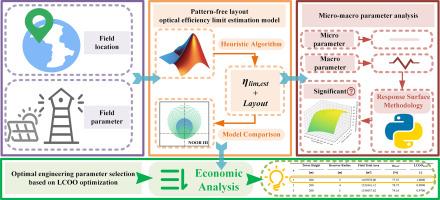A novel theoretical optical efficiency limit estimation model guiding parameter design of solar power tower heliostat fields with pattern-free layout
IF 11
1区 工程技术
Q1 ENERGY & FUELS
引用次数: 0
Abstract
The heliostat field, as the critical energy conversion component of Solar Power Tower (SPT) systems, requires precise modeling of its optical efficiency limit to guide system parameter optimization. Existing models tend to overestimate theoretical optical efficiency limits by neglecting significant shadowing and blocking losses, while most optimization methods lack universal guidance for heliostat field design. This study proposes a pattern-free layout model to estimate optical efficiency limits more realistically. By incorporating a mechanism that screens shadowing and blocking losses under ideal distance constraints, the model corrects these overestimations. Additionally, the high-freedom layout strategy, without preset symmetry, overcomes traditional performance limitations. Compared to the existing model, the proposed model reduces the overestimation of optical efficiency limits by 8.92 % for large heliostat field. The study reveals that macro parameters, such as tower height and heliostat total area, have a dominant effect on efficiency limits, while micro parameters have a negligible impact. Through response surface methodology, a second-order regression model was developed to quantify the interactions among macro parameters, achieving a high prediction accuracy (R2 = 0.888). The study also investigates the optimal levelized cost of optical parameter combinations and heliostat field layouts at 30°N, with the results showing that the parameter combinations are significantly lower than those for the optimal optical efficiency limit estimation. The optimal layouts exhibit a consistent umbrella-like shape, emphasizing the importance of layout in field performance. This study provides a more realistic optical efficiency limit estimation, offering valuable insights into parameter optimization for the design of next-generation SPT.

建立了一种新的理论光效率极限估计模型,指导无图案布局太阳能塔式定日镜场参数设计
定日镜作为太阳能发电塔(SPT)系统的关键能量转换部件,需要对其光效率极限进行精确建模,以指导系统参数优化。现有模型忽略了显著的遮蔽和遮挡损失,往往高估了理论光学效率极限,而大多数优化方法缺乏定日镜场设计的通用指导。本研究提出一种无模式布局模型,以更真实地估计光效率极限。通过结合一种机制,在理想距离约束下屏蔽阴影和阻挡损失,该模型纠正了这些高估。此外,高自由度布局策略,没有预设的对称性,克服了传统的性能限制。与现有模型相比,该模型对大定日镜视场光学效率极限的高估降低了8.92%。研究表明,塔架高度和定日镜总面积等宏观参数对效率限制的影响占主导地位,而微观参数对效率限制的影响可以忽略不计。通过响应面法建立二阶回归模型,量化宏观参数之间的相互作用,预测精度较高(R2 = 0.888)。研究了30°N下光学参数组合和定日镜场布局的最优平准化成本,结果表明,这些参数组合明显低于最优光学效率极限估计。最佳布局呈现出一致的伞状形状,强调了布局对现场性能的重要性。该研究提供了一个更现实的光效率极限估计,为下一代SPT的参数优化设计提供了有价值的见解。
本文章由计算机程序翻译,如有差异,请以英文原文为准。
求助全文
约1分钟内获得全文
求助全文
来源期刊

Applied Energy
工程技术-工程:化工
CiteScore
21.20
自引率
10.70%
发文量
1830
审稿时长
41 days
期刊介绍:
Applied Energy serves as a platform for sharing innovations, research, development, and demonstrations in energy conversion, conservation, and sustainable energy systems. The journal covers topics such as optimal energy resource use, environmental pollutant mitigation, and energy process analysis. It welcomes original papers, review articles, technical notes, and letters to the editor. Authors are encouraged to submit manuscripts that bridge the gap between research, development, and implementation. The journal addresses a wide spectrum of topics, including fossil and renewable energy technologies, energy economics, and environmental impacts. Applied Energy also explores modeling and forecasting, conservation strategies, and the social and economic implications of energy policies, including climate change mitigation. It is complemented by the open-access journal Advances in Applied Energy.
 求助内容:
求助内容: 应助结果提醒方式:
应助结果提醒方式:


